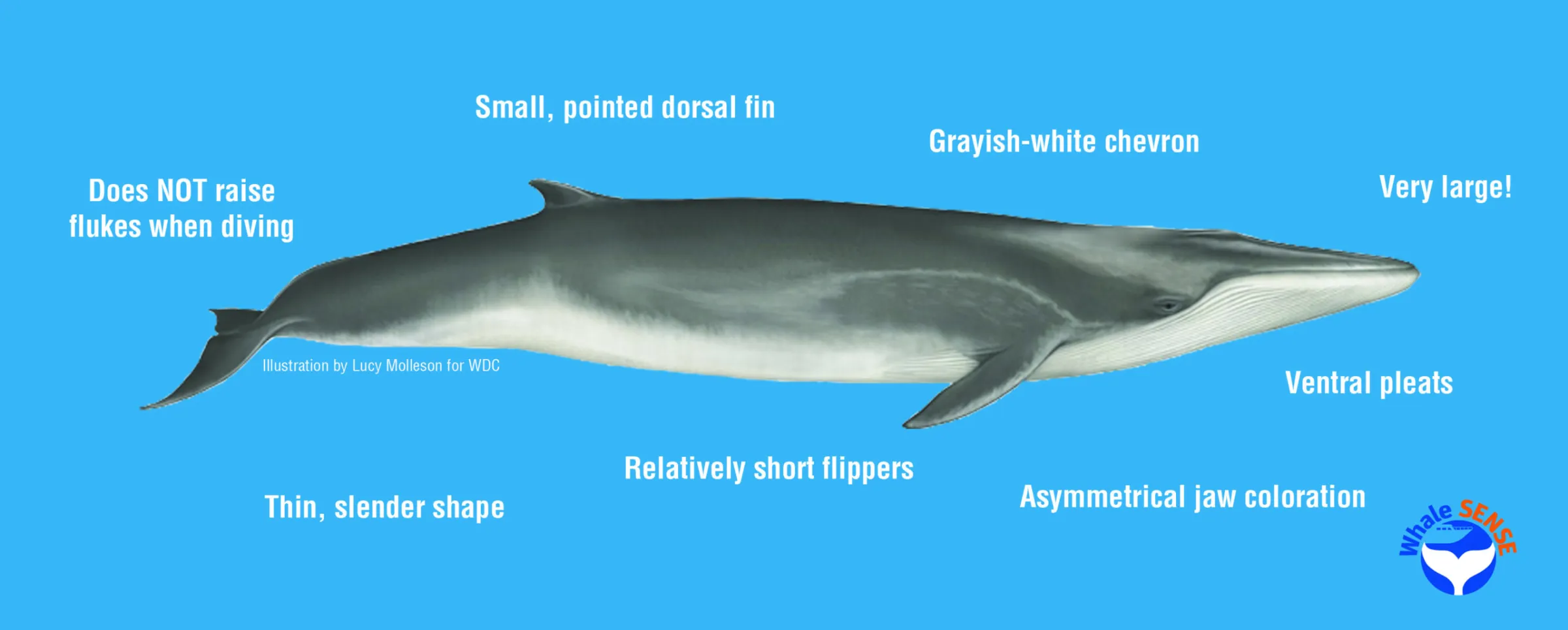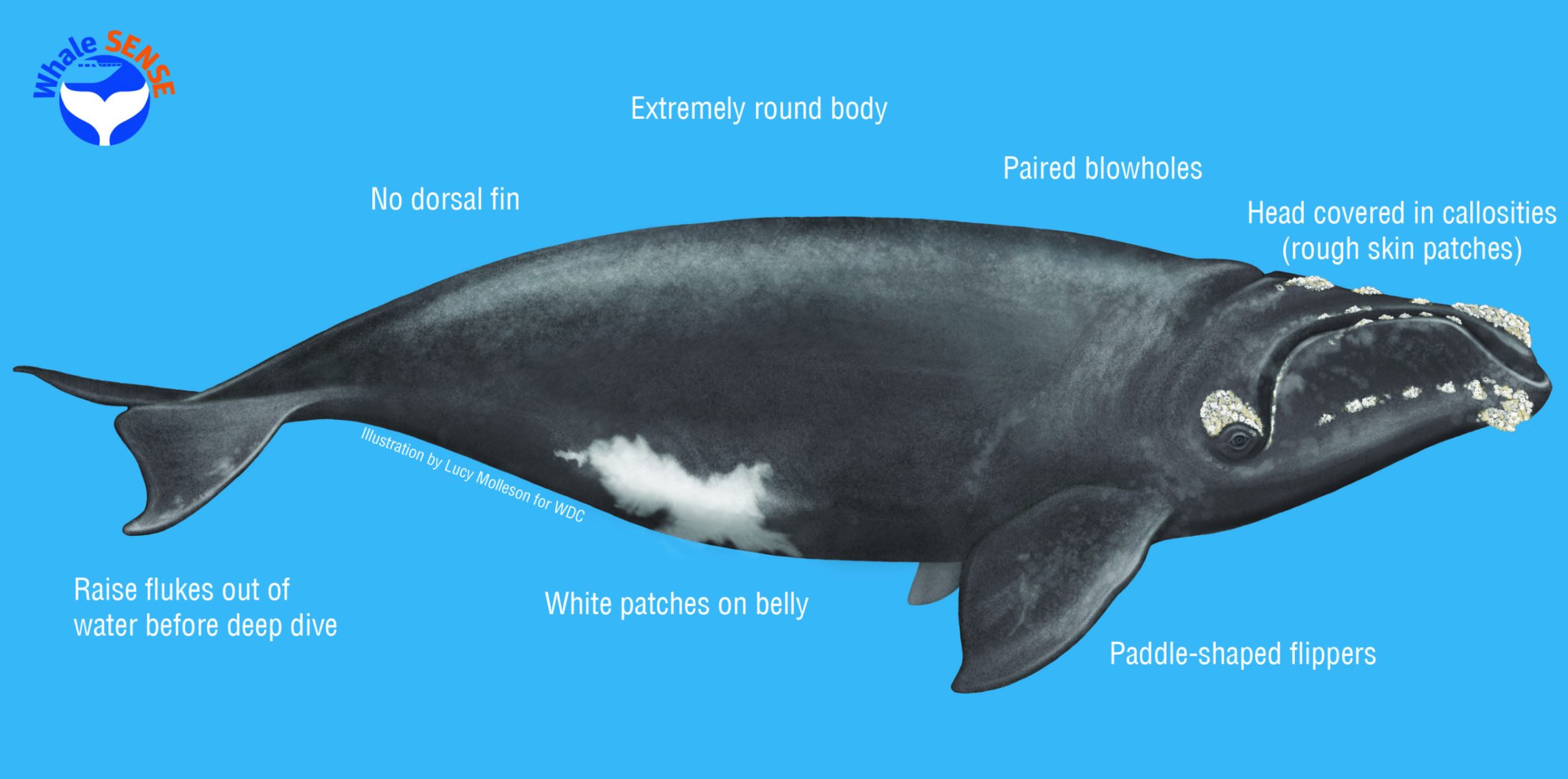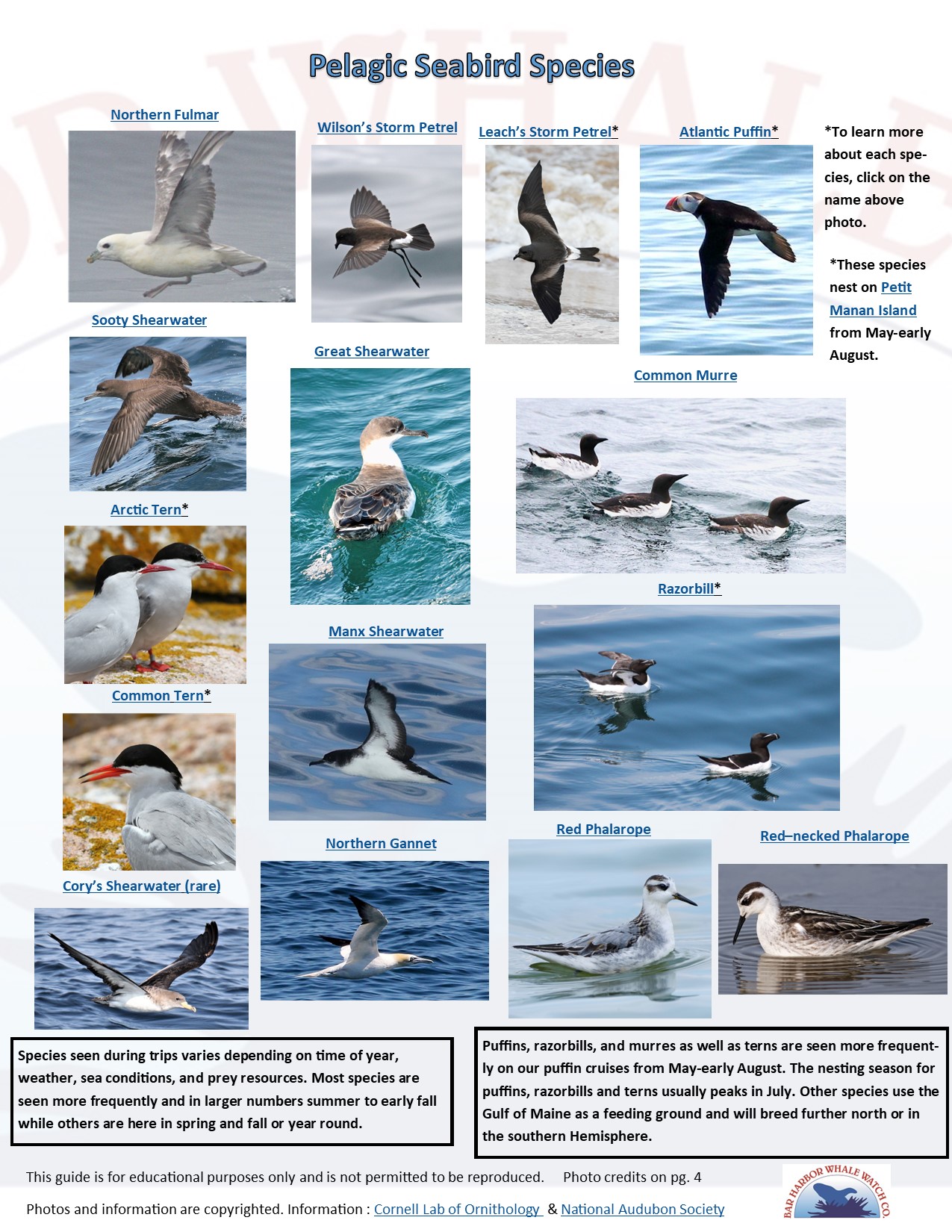CLICK ON THE IMAGES BELOW TO LEARN MORE ABOUT EACH SPECIES!
BALEEN WHALES
-
Whales are divided into multiple sub-groups based on physical, genetic, and behavioral characteristics. In the taxonomic group, Cetacea (Latin term for whales) there are two major groups:
Baleen whales-14 species worldwide
Toothed Whales- 42 species of dolphin and 7 species of porpoise worldwide
Baleen whales do not have teeth. Instead they have hundred of keratin plates called baleen that act to create a filtration/sieve system in the mouth. This allows them to consume thousands of individual prey items in one big gulp or up to several tons of prey a day! As they engulf their prey, they must expel the seawater out of their mouths before swallowing their prey whole.
FIN WHALE
-
Nope! Whales are placental mammals just like us!
This means whales:
- Breath air using their lungs-they inhale and exhale through a single or two blowholes (their nostrils) on the top of the head
- Warm-blooded-they stay warm with a thick layer of fat called blubber
- Give birth to live young (one calf per birth)
- Feed their young milk- up to 100 gallons a day for the larger whale species!
- Have hair-usually small hairs on or around the rostrum and in some cases above the eyes and on their chins. Most likely sensory hairs to help locate food.
HUMPBACK WHALE
-
Fluking or seeing the tail or flukes being lifted out of the water, depends on the species of whale. This helps the whale take a deep or terminal dive by pointing the head down into the water.
We often see this with baleen whales such as humpback and North Atlantic right whales. This is because they have a much thicker layer of blubber that results in being more buoyant.
Bottom photo credit: Beverly Orthwein
This is a female humpback named Fan. The top photo was photographed on one of trips in 2020, while bottom photo was taken in 2021. Can you see how she got her name? We see whale return to the same feeding grounds year-after-year. Some we’ve continued to see for over 40 years!
The North Atlantic Catalog is managed by in Bar Harbor and the Gulf of Maine catalog is managed by the in Provincetown, Massachusetts. There are now more than 10,000 individuals documented in the North Atlantic humpback whale catalog! Check out this fun game!
MINKE WHALE
-
Breaching is an exciting behavior. This is when the whale pulls it body, or a portion of it, out of the water, resulting in a large splash at the surface.
Several whale species can be observing breaching, however, we tend of observe humpback whales demonstrate this behavior more often. They have been documented doing a variety of breaching behaviors such as a:
- tail breach
- spinning head or near 360 degree spinning breach
- chin breach or slap
We are not sure why they breach, but a working hypothesis speculates it may be a form of communication, such as helping whales to locate each other or possibly drive others away by using the sound created by the whale’s body hitting the water . Others hypothesize it could assist in stunning prey and aid in digestion. It is most likely for multiple reasons depending on a number of factors. Until we can ask the whales’ themselves, more research will help us learn more about this interesting behavior.
How often do we see a whale breach?
It is rare. We would estimate about 50% of all our trips witness a breaching whale. But no matter what the whales are doing, every trip is a unique and exciting experience with these incredible animals!
Check out Why do whales breach to learn more!
NORTH ATLANTIC RIGHT WHALE
-
In regards to number of different kinds or species, scientists recognize 90 different species of cetaceans or whales, dolphins, and porpoise.
When breaking it down to total number of whales found in the world, it depends on the species and regions they are found. Some species are more difficult to track and study due to the nature of their movement patterns and distribution. This can make it tricky to get annual updated population statistics. Populations of whales can be impacted by naturally occurring phenomena or stressors (disease and prey source shift) and/or human related activities such as pollution, fisheries interactions (entanglements), ship strikes, and climate change amplification.
Photo identification, acoustics, and genetics have allowed scientists learn a great deal about the structure of stocks and populations of different species.
In the Gulf of Maine/North Atlantic, the estimated population of each species includes:
Baleen Whales:
- Fin Whale- Endangered, ~6,800 individuals
- Humpback Whale- Recovered ~1390 individuals, removed off the Endangered Species List in 2016, still protected under the Marine Mammal Protection Act (MMA)
- Minke Whale- Protected, ~21,968 individuals
- North Atlantic right whale- Critically endangered, ~368 individuals
- Sei Whale- Protected ~6,929 individuals
Toothed Whales
- Atlantic white-sided dolphin- Protected, ~93,233
- Bottlenose dolphin (offshore)-Protected, 62,851
- Common dolphin –Protected, ~172,874
- Harbor porpoise- Protected, ~95,543
- Sperm Whale-Protected, ~4,349
*Estimated stock data published in NOAA Fisheries Stock Assessments
SEI WHALE
TOOTHED WHALES (DOLPHINS & PORPOISES)
-
Toothed whales or cetaceans are divided into two sub-groups:
Dolphins-42 species worldwide. Examples: Bottlenose dolphin, killer whales, and pilot whales
Porpoise-7 species worldwide. Examples: Harbor porpoise, Dall’s porpoise, and vaquita
Sperm whales-Family:Physeteridae
These whales do have teeth and use them mainly for catching prey such as fish and squid. Dolphins and porpoise are different both anatomically and behaviorally.
To learn more about toothed whales and the difference between each sub-group, click HERE!
ATLANTIC WHITE-SIDED DOLPHIN
-
Whales rely on SOUND to communicate as well as locate and capture prey. They essentially use sound to “see” objects or find other whales in close proximity or over miles away from their current location in the ocean. Whales can visually see what is below or above them or in close proximity to their eyes, but they use the enhanced amplification of sound as a means of surviving as fully aquatic animal that spends about 90% of its life below the surface.
Check out this great video: Why Do Whales Sing?
Large whales typically communicate over large distances (sometimes hundreds of miles), due to the low frequency sounds they produce, while toothed whales produce high frequency whistles and clicks.
Toothed whales use echolocation to hunt and navigate underwater. They emit sounds waves from an area around their blowhole (The Monkey Lips) and a fatty melon on their forehead helps to focus the sound toward an object. The sounds waves then bounce off an object and then return to the whale through the lower jaw that is full of oil that then directs the sound waves to the ear bones.
Sperm whales produce the most powerful sounds, up to 230 decibels, louder than a jet-plane! Check out this amazing video about Sperm Whales and Echolocation
Blue and fin whales communicate over very long distances. Many baleen whales “sing” or produce low frequency, repeating sounds. Baleen whales use muscles in their throat and chest, that contract and move air from across the lungs, across a u-fold and into laryngeal sacs, which cause the u-fold to vibrate. This results in sound that resonates in the laryngeal sacs. They don’t inhale to keep singing, the air in the lungs is recycled back into the lungs.
Whales are documented to have their own dialects and unique acoustic patterns that repeat and can be learned by other individuals.
BOTTLENOSE DOLPHIN
-
A group of whales is called a pod. Toothed whales such a dolphins are often associated with this term, but it can apply to larger whales as well.
Pods can consist of two whales up to hundreds of individuals, depending on the species and other factors such as feeding and breeding. Finding and foraging on prey as well as mating, can result in many whales congregating in large groups or in smaller sub-groups. Toothed whales are known to be highly social animals, with their pods consisting of tight knit family groups. This is observed in killer whales, pilot whales, and sperm whales. Checking out this interested video on Killer Whale Matriarchy
On our whale watches, we often Atlantic white-sided dolphins and common dolphins in pods consisting of about 10-20 individuals, but have seen pods of over 100 individuals time-to-time. These pods usually consist of related females and their offspring. Harbor porpoise are a frequently seen during the summer in large feeding groups.
Baleen whales can travel in pairs or groups of nearly a dozen (sometimes more), possibly participating in cooperative feeding or working together to corral prey. With humpback whales, we’ve observed long and short term associations between individuals, but these associations are usually very short. Research on social behavior of baleen whales will help us to further understand group function, benefits, and context. Check out this great video on Humpback Group Feeding.
Some whales are found feeding, resting, and traveling alone. It is common to find larger whale species not in a group with other whales. They may join up with other individuals at some point.
Mother and calves with have a strong bond and remain together either for a year or two, while others will stay with their mothers throughout their lifetime, depending on the species of whale.
SHORT-BEAKED COMMON DOLPHIN
-
Though they are both toothed whales and look similar, porpoise and dolphins are separated into sub-groups based on:
- Tooth structure: porpoise tend to have spade-shaped teeth, while dolphins have conical-shaped teeth
- Body size: porpoise tend to be smaller compared to member of the dolphin family
- Shape of the dorsal fin: porpoises have a triangular-shaped dorsal, dolphins have curved dorsal
- Face/head structure: porpoises have a blunt snout and smaller mouth while dolphins have a longer, beak-like snout
Check out How are porpoises different from dolphins, to learn more!
HARBOR PORPOISE
-
Yes, in a way, but much differently then we do! Humans can fully fall asleep because we are involuntary breathers (don’t have to necessarily think of every breath we take). Whales, as air breathing mammals that live in the ocean, are voluntary breathers and have to remain partially conscious in order to keep themselves breathing and monitoring their environment.
Essentially, they shut down half of their brain, allowing one hemisphere to “rest” at a time or known as unihemispheric sleep.
Occasionally, we come across sleeping whales or they decide to take a quick catnap or snooze while we are with them.
More great information here: Do Whales Ever Sleep?
SPERM WHALE
PINNIPEDS-TRUE SEALS
-
True seals, sea lions, fur seals, and walruses are all in the same class of marine mammals called pinnipeds. The term pinniped essentially translates to wing-footed mammal as they have webbed front and hind flipper used for steering, propulsion, scratching, communication, and feeding.
There are three sub-groups:
Otariidae: sea lions and fur seals
-California sea lion
-Northern fur seal
Phocidae: true seals
-Harbor seal
-Gray seal
Odobenidae: walrus
-Atlantic walrus
-Pacific walrus
Sea lions and fur seals are not found on the east coast of the continental US and Atlantic walrus are found in the Arctic Ocean. In Maine, we have two common species of true seals that can be found here mostly year round, as well as a couple of arctic species that visit occasionally in the winter months.
Physical and behavioral characteristics result in different pinniped species. Here are some key differences:
Image: National Park Service
GRAY SEAL
HARBOR SEAL
MARINE FISH & SHARKS
OCEAN SUNFISH
BASKING SHARK
SEABIRDS
-
If you have any questions you would like to ask of our naturalists, please feel free to email us [email protected]!
Feel free to check out our Educational Resources page! We have links to organizations that focus on research and education that provide excellent information and additional resources!















